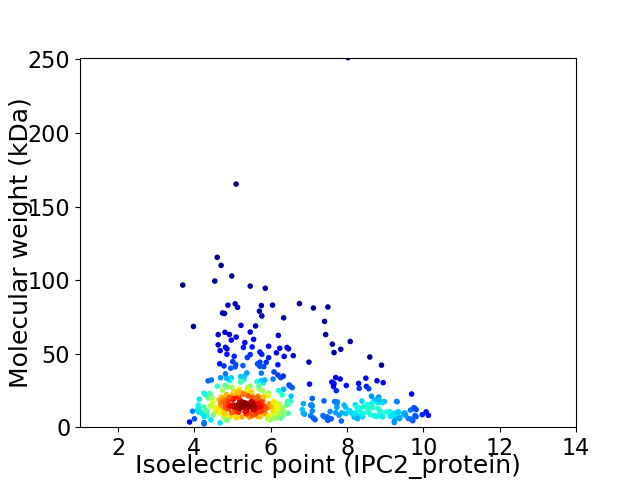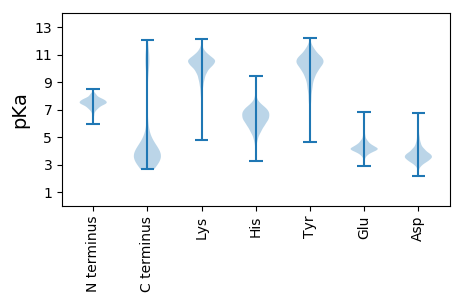
Pseudomonas phage Phabio
Taxonomy: Viruses; Duplodnaviria; Heunggongvirae; Uroviricota; Caudoviricetes; Caudovirales; Myoviridae; Phikzvirus; unclassified Phikzvirus
Average proteome isoelectric point is 6.19
Get precalculated fractions of proteins

Virtual 2D-PAGE plot for 468 proteins (isoelectric point calculated using IPC2_protein)
Get csv file with sequences according to given criteria:
* You can choose from 21 different methods for calculating isoelectric point
Summary statistics related to proteome-wise predictions



Protein with the lowest isoelectric point:
>tr|A0A1Y0STA7|A0A1Y0STA7_9CAUD Uncharacterized protein OS=Pseudomonas phage Phabio OX=2006668 GN=PHABIO_80 PE=4 SV=1
MM1 pKa = 7.34EE2 pKa = 5.34VIADD6 pKa = 4.14ICQLSLSDD14 pKa = 3.93LTDD17 pKa = 3.66FAIAYY22 pKa = 9.57VEE24 pKa = 4.14YY25 pKa = 10.28EE26 pKa = 4.08DD27 pKa = 4.94VGGNFMNDD35 pKa = 3.12DD36 pKa = 4.99DD37 pKa = 5.69LVQDD41 pKa = 3.7YY42 pKa = 10.9FGGKK46 pKa = 8.21NVGYY50 pKa = 9.84RR51 pKa = 11.84VIEE54 pKa = 4.31IIRR57 pKa = 11.84AQRR60 pKa = 11.84CEE62 pKa = 3.51IMAYY66 pKa = 9.39MPDD69 pKa = 3.3NVVEE73 pKa = 4.18MKK75 pKa = 10.07YY76 pKa = 10.82ACTRR80 pKa = 11.84GDD82 pKa = 3.52GVFVYY87 pKa = 10.65ARR89 pKa = 11.84TANDD93 pKa = 3.23VNVGG97 pKa = 3.43
MM1 pKa = 7.34EE2 pKa = 5.34VIADD6 pKa = 4.14ICQLSLSDD14 pKa = 3.93LTDD17 pKa = 3.66FAIAYY22 pKa = 9.57VEE24 pKa = 4.14YY25 pKa = 10.28EE26 pKa = 4.08DD27 pKa = 4.94VGGNFMNDD35 pKa = 3.12DD36 pKa = 4.99DD37 pKa = 5.69LVQDD41 pKa = 3.7YY42 pKa = 10.9FGGKK46 pKa = 8.21NVGYY50 pKa = 9.84RR51 pKa = 11.84VIEE54 pKa = 4.31IIRR57 pKa = 11.84AQRR60 pKa = 11.84CEE62 pKa = 3.51IMAYY66 pKa = 9.39MPDD69 pKa = 3.3NVVEE73 pKa = 4.18MKK75 pKa = 10.07YY76 pKa = 10.82ACTRR80 pKa = 11.84GDD82 pKa = 3.52GVFVYY87 pKa = 10.65ARR89 pKa = 11.84TANDD93 pKa = 3.23VNVGG97 pKa = 3.43
Molecular weight: 10.9 kDa
Isoelectric point according different methods:
Protein with the highest isoelectric point:
>tr|A0A1Y0SWH4|A0A1Y0SWH4_9CAUD Uncharacterized protein OS=Pseudomonas phage Phabio OX=2006668 GN=PHABIO_303 PE=4 SV=1
MM1 pKa = 7.19YY2 pKa = 10.02DD3 pKa = 3.19KK4 pKa = 11.37VSILKK9 pKa = 9.46QVNVTASNSTSPIGEE24 pKa = 4.15APDD27 pKa = 3.57LKK29 pKa = 10.66GISVGEE35 pKa = 4.2LIAAARR41 pKa = 11.84ARR43 pKa = 11.84SNNTAVAQLVDD54 pKa = 3.8WASKK58 pKa = 9.95FPPSKK63 pKa = 10.15RR64 pKa = 11.84RR65 pKa = 11.84SLYY68 pKa = 10.16RR69 pKa = 11.84RR70 pKa = 11.84ATAPIRR76 pKa = 11.84RR77 pKa = 11.84QWHH80 pKa = 6.37RR81 pKa = 11.84IKK83 pKa = 10.33ATYY86 pKa = 10.16NYY88 pKa = 7.43WKK90 pKa = 10.6NYY92 pKa = 8.27
MM1 pKa = 7.19YY2 pKa = 10.02DD3 pKa = 3.19KK4 pKa = 11.37VSILKK9 pKa = 9.46QVNVTASNSTSPIGEE24 pKa = 4.15APDD27 pKa = 3.57LKK29 pKa = 10.66GISVGEE35 pKa = 4.2LIAAARR41 pKa = 11.84ARR43 pKa = 11.84SNNTAVAQLVDD54 pKa = 3.8WASKK58 pKa = 9.95FPPSKK63 pKa = 10.15RR64 pKa = 11.84RR65 pKa = 11.84SLYY68 pKa = 10.16RR69 pKa = 11.84RR70 pKa = 11.84ATAPIRR76 pKa = 11.84RR77 pKa = 11.84QWHH80 pKa = 6.37RR81 pKa = 11.84IKK83 pKa = 10.33ATYY86 pKa = 10.16NYY88 pKa = 7.43WKK90 pKa = 10.6NYY92 pKa = 8.27
Molecular weight: 10.42 kDa
Isoelectric point according different methods:
Peptides (in silico digests for buttom-up proteomics)
Below you can find in silico digests of the whole proteome with Trypsin, Chymotrypsin, Trypsin+LysC, LysN, ArgC proteases suitable for different mass spec machines.| Try ESI |
 |
|---|
| ChTry ESI |
 |
|---|
| ArgC ESI |
 |
|---|
| LysN ESI |
 |
|---|
| TryLysC ESI |
 |
|---|
| Try MALDI |
 |
|---|
| ChTry MALDI |
 |
|---|
| ArgC MALDI |
 |
|---|
| LysN MALDI |
 |
|---|
| TryLysC MALDI |
 |
|---|
| Try LTQ |
 |
|---|
| ChTry LTQ |
 |
|---|
| ArgC LTQ |
 |
|---|
| LysN LTQ |
 |
|---|
| TryLysC LTQ |
 |
|---|
| Try MSlow |
 |
|---|
| ChTry MSlow |
 |
|---|
| ArgC MSlow |
 |
|---|
| LysN MSlow |
 |
|---|
| TryLysC MSlow |
 |
|---|
| Try MShigh |
 |
|---|
| ChTry MShigh |
 |
|---|
| ArgC MShigh |
 |
|---|
| LysN MShigh |
 |
|---|
| TryLysC MShigh |
 |
|---|
General Statistics
Number of major isoforms |
Number of additional isoforms |
Number of all proteins |
Number of amino acids |
Min. Seq. Length |
Max. Seq. Length |
Avg. Seq. Length |
Avg. Mol. Weight |
|---|---|---|---|---|---|---|---|
0 |
97552 |
18 |
2326 |
208.4 |
23.59 |
Amino acid frequency
Ala |
Cys |
Asp |
Glu |
Phe |
Gly |
His |
Ile |
Lys |
Leu |
|---|---|---|---|---|---|---|---|---|---|
6.885 ± 0.164 | 0.979 ± 0.047 |
6.491 ± 0.109 | 6.712 ± 0.13 |
4.121 ± 0.067 | 6.282 ± 0.163 |
2.119 ± 0.07 | 6.253 ± 0.099 |
6.097 ± 0.112 | 8.439 ± 0.099 |
Met |
Asn |
Gln |
Pro |
Arg |
Ser |
Thr |
Val |
Trp |
Tyr |
|---|---|---|---|---|---|---|---|---|---|
2.776 ± 0.07 | 5.189 ± 0.103 |
4.139 ± 0.074 | 3.634 ± 0.079 |
5.102 ± 0.094 | 5.679 ± 0.102 |
6.455 ± 0.093 | 7.163 ± 0.107 |
1.336 ± 0.051 | 4.15 ± 0.088 |
Most of the basic statistics you can see at this page can be downloaded from this CSV file
Proteome-pI is available under Creative Commons Attribution-NoDerivs license, for more details see here
| Reference: Kozlowski LP. Proteome-pI 2.0: Proteome Isoelectric Point Database Update. Nucleic Acids Res. 2021, doi: 10.1093/nar/gkab944 | Contact: Lukasz P. Kozlowski |
